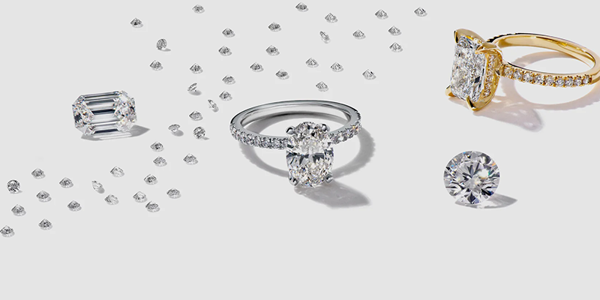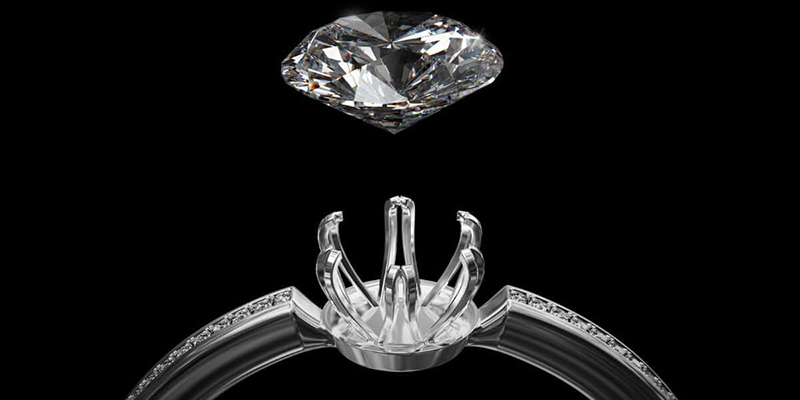Many people have found themselves staring at a stunning display of sparkling diamond jewellery, feeling both amazed and completely overwhelmed. It's easy to get lost in the beauty but struggle to figure out which piece is right for you. What makes one diamond stand out as more valuable or memorable than another?

Buying diamond jewellery is a big deal, whether for love, success, or celebrating yourself. But for someone new to the process, it can feel like stepping into a confusing maze filled with endless choices, technical terms, and things to consider.
That's where a diamond jewellery guide comes in. It's your go-to resource for everything you need to know, whether you're shopping for an engagement ring, a special gift, or something beautiful to treat yourself.
We'll manage to cover everything beginners need to know about buying diamonds, from 4 Cs with trade secrets to empowering information that would make the right decision and set your sights on that perfect diamond, all sparkly and dreamy bright.
Yesterday, today, and forever, diamonds have reigned supreme in hearts and hold captive hearts for an everlasting symbol of love, power, and beauty.
More than symbols of belief, though, diamonds are investments. They are tough, rarely go out of style, and are multipurpose—from engagement rings to everyday accessories.
Just like people, however, not all diamonds are created equal. The next step is to know what makes a diamond different from a much cheaper stone.
That's where the 4 Cs come in. These are by far the most critical considerations in determining the quality of a diamond and its value, so let's explore each twist we can.
There are four Cs, and cut is the most critical aspect. Cut does not pertain to shape; it refers to how well the diamond was cut and polished. The refinement of cutting means how well it reflects light and how well the sparkle we all admire shines. For all diamond buyers, whether beginners or experts, cut quality is one on the checklist: spell magic into life.
Diamonds range from colourless (a diamond with no colour) to slightly yellow, with some browns. The most colourless (less colour) are generally valued more, and thus, according to the GIA scale, diamond colours are measured from D (colourless) to Z (light).
Clarity refers to imperfections, either internal (inclusions) or external (blemishes). A more apparent diamond will then have a higher clarity rating. However, several inclusions not visible under a microscope can save you a fortune on diamonds outside this price range.
The carat weight measures the size of the diamond. While larger diamonds are rarer and more expensive, size isn't everything. A smaller diamond with excellent cut, colour, and clarity can outshine a larger one with poor grades. Balance carat weight with the other Cs to find the best value.
After selecting your diamond, the next step is to choose the right setting. The setting holds the diamond in place, enhances its beauty, and complements your style. Here are some popular options:
Prong Setting: Classic and timeless prong settings allow maximum light to enter the diamond, enhancing its sparkle.

Bezel Setting: Bezel settings are modern and very secure and surround the diamond with a sleek, protective metal rim.
Halo Setting: A halo of small diamonds envelops the stone at the centre, adding brilliance and creating the illusion of a bigger diamond.
Pavé Setting: Little diamonds are set closely together in the band, adding glamour and twinkling.
When choosing a setting, consider your lifestyle and preferences. Do you want something more classic and subdued or bold and dramatic? Your setting should match your personality and make your diamond shine all the brighter.
Choosing the precious metal for your diamond jewellery can decide the stand of the adornment and how long it would stand before becoming tarnished. Here's a simple intro to these well-known choices:
Platinum: Naturally white, durable, and hypoallergenic, platinum stands on top of diamond jewellery.
White Gold: White gold is a less expensive alternative to platinum, which resembles it but requires rhodium plating to keep its shine.
Yellow Gold: The classical, warm yellow gold adds an old-fashioned touch to diamond jewellery.
Rose Gold: Romance or modernity speaks to most with a new definition offered by rose gold.
Pick a metal that complements your skin tone and personal aesthetic. Metals are charming in their way and can make a world of difference in the appearance of your diamond.
Now to the point. It is to be understood that buying diamond jewellery costs a lot of money; therefore, a person needs to fix the budget and stick to it. Here are some diamond-purchasing tips:
The 4 Cs should be prioritised: Choose the essential factors for you and make way for the budget. For example, if sparkle is your priority, spend more on the cut grade.
Always consider Lab-grown diamonds. They are similar to real diamonds in beauty and quality but much less expensive.
Shop Around: Research jewellers and online retailers to find which has the best price.
Search for Certifications: Diamonds should be GIA or AGS-certified for quality and authenticity.
Sometimes, whether buying a diamond for yourself or gifting it to someone special, it becomes more than just a piece of jewellery. It holds your emotions, memories, and moments, ready to be treasured and passed down as a timeless heirloom. It carries your story, whispering it to future generations.
So, take your time, explore your options, and trust your instincts. This diamond jewellery guide is here to give you the knowledge and confidence to make a choice that shines as brightly as your dreams.
Now, go ahead and find that stunning diamond. Your story is ready to sparkle.